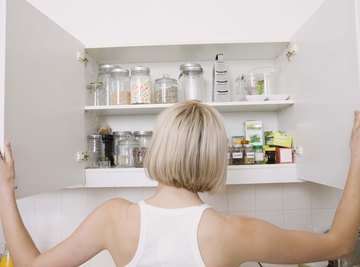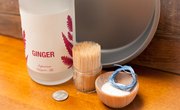
Science experiments don't require a lot of special equipment or a long time to set up. You can perform fun and educational experiments right in your own home that are just as exciting and intriguing as those you'd conduct in a laboratory, and you can do them in only 10 minutes.
Repelling Pepper
Fill a large dish with water, and then sprinkle a significant amount of pepper onto the water. Once you have a lot of pepper floating in the water, dip your finger into some dish soap. Then, dip your finger into the center of the water dish. The pepper will move quickly away from your finger, as though the dish soap has repelled it. However, what has actually happened is that the dish soap has broken the surface tension of the water and caused the water molecules to move away, carrying the pepper along with them.
Stratifying Liquids
Fill five glasses each with a small amount of one of five liquids: pancake syrup, dish soap, water, rubbing alcohol and vegetable oil. Add a different color of food coloring to each glass, and mix the color into the liquid. Pour the syrup into a clean, tall glass. Then pour the dish soap into that same glass. Pour it down the inside of the glass so it sits on top of the syrup instead of mixing with it. Pour in each of the other liquids in the same way and in this order: water, rubbing alcohol and vegetable oil. The liquids will all sit on top of one another, creating bands of colors, and demonstrating how heterogeneous liquids -- such as those on Jupiter -- can form separate distinct bands.
Separating Salt and Pepper
Mix some salt and pepper together, and then spread the mixture out on a sheet of paper. Blow up a balloon and tie it shut. Then rub the balloon either on your hair or on a piece of wool. Slowly lower the balloon toward the paper, and watch as the pepper flies up to the balloon, leaving the salt behind on the paper. The reason the pepper attracts toward the balloon is that the balloon is negatively charged while the pepper carries a positive charge. The salt also carries a positive charge, but the attraction is too weak to cause the heavier salt to defy gravity.
Inverting the Egg Chute
Carefully insert two or three birthday candles into one end of a hard-boiled egg, and then light the candles. Hold a bottle with a mouth slightly smaller than the egg upside-down, and place the end of the egg into the bottle, candles first. Watch as the candles extinguish and then as the egg squeezes itself up into the bottle, seemingly defying gravity. When the lit candles are in the bottle, the heat causes the air molecules to move apart, and some even escape the bottle. When the flames go out, the molecules cool down and create a partial vacuum. The external pressure is then greater than the internal pressure, which pushes the egg all the way into the bottle.
References
About the Author
Christopher Cascio is a memoirist and holds a Master of Fine Arts in creative writing and literature from Southampton Arts at Stony Brook Southampton, and a Bachelor of Arts in English with an emphasis in the rhetoric of fiction from Pennsylvania State University. His literary work has appeared in "The Southampton Review," "Feathertale," "Kalliope" and "The Rose and Thorn Journal."
Photo Credits
Jupiterimages/Polka Dot/Getty Images
